| Home
Archives
Archives before June 13, 2001
RSS Feed
Adaptive
Path (my company!)
About
peterme
Coordinates
Most of the Time
Oakland, CA
Interests
Current
American history around the time of the Revolution, figuring out how to marry top-down task-based information architecture processes with bottom-up document-based ones, finding a good dentist in San Francisco Oakland
Perennial
Designing
the user experience (interaction design, information architecture, user
research, etc.), cognitive science, ice cream, films and film theory,
girls, commuter bicycling, coffee, travel, theoretical physics for laypeople,
single malt scotch, fresh salmon nigiri, hanging out, comics formalism,
applied complexity theory, Krispy Kreme donuts.
surf
Click
to see where I wander.
Wish
list
Show
me you love me by
buying
me things.
Spyonme
Track updates of
this page with Spyonit. Clickee
here.
Essays
[Editor's note: peterme.com
began as a site of self-published essays, a la Stating
The Obvious. This evolved (or devolved) towards link lists and shorter
thoughtpieces. These essays are getting a tad old, but have some good
ideas.]
Reader Favorites
Interface
Design Recommended Reading List
Whose
"My" Is It Anyway?
Frames:
Information Vs. Application
Subjects
Interface Design
Web Development
Movie Reviews
Travel
|
|
| September 29, 2002 |
|
Foodie post #3. Jeremiah's Pick Coffee. Piedmont Grocery features Jeremiah's Pick coffee. They offered free tastings at the customer appreciation day, and it was quite good. I bought a pound, and it's been holding up, as good as anything from Peet's, and about the same price, maybe a little less. They only sell through online and in fancy-pants grocery stores. Definitely worth trying!
Posted at 11:58 AM PST [2 comments]
|
|
Foodie post #2: Mezzo Secco cheese and an amazing pasta recipe. At customer appreciation day at the Piedmont Grocery, I was turned onto a local artisan cheese, Mezzo Secco. It's an amazing cheese, tangy and delightful. In-store, a five-star chef and representative of California artisan cheeses (and rapid left-winger) was preparing a pasta dish with the cheese, and gave us all this recipe, transcribed by Stacy, with her comments. My friends Trav and Jenny cooked it up a couple nights ago, and it was a treat. Here it is:Pasta Carbonara
Ingredients:
1/4 cup extra virgin olive oil
2-3 garlic cloves (it doesn't say to chop or not, probably mince it)
A pinch red pepper flakes (you have these on the stove)
2 slices bacon or pancetta (needs to be chopped up)
4 oz. greens, trimmed and washed (this is optional, really)
salt and pepper to taste (fresh ground pepper is gooood in this)
fresh herbs to taste (or dried, if you like, but not essential. basil would be best, and parsley)
1lb spaghetti (I like linguini in carbonara better, myself (And we used fettucine, and it was fine)
2 eggs, lightly beaten (hit with stick)
3 oz. grated firm cheese (you could even mix parmesan and mezzo secco, and how much is 3oz anyway? Not enough!! actually, 3oz is plenty, and what the chef taught us is that it's just as good, if not better, to simply hand-crumble the cheese--allowing cheese bits to remain unmelted and oh so tasty)
Directions:
1. Sweat the garlic in the oil without browning (medium heat on stove)
2. When garlic is soft, add the pepper flakes and cook for a minute. Add the meat and cook for a few minutes more.
3. Add the greens, cook until wilted. Season with salt, pepper, and herbs.
4. Meanwhile, bring ample amounts of lightly salted water to a rolling boil. Cook the pasta according to package directions, only STOP 2 MINUTES EARLY. Remove 1/2 cup of the pasta liquid and reserve before draining pasta.
5. Add the pasta and reserved water to the pan with the other stuff, and cook over medium heat until the water is absorbed and the pasta is coated with stuff. (This stuff with the pasta water is essential. It allows the sauce to better stick to the pasta. It's a real treat.)
6. Add the egg, take off the heat and toss until the egg cooks (no longer slimy, little white bits adhering to pasta), then fold in the cheeese.
7. Eat eat eat. Yum yum yum.
And there you have it. It was *so good.*
Posted at 11:52 AM PST [5 comments]
|
|
Foodie post #1. Piedmont Grocery. The first in a few posts on yuppie food bliss. About 5 blocks from my house is the Piedmont Grocery, the local grocery store. Amazingly, it's been there for 100 years. And while it's prices aren't the cheapest, I adore it. They carry the highest quality meats, produce, and dairy, the staff their is remarkably personable, and the store is clearly very much a part of its community (from the crowded bulletin board postings to the "customer appreciation day" with lots of amazing tastings (including Niman Ranch bacon, organic egg omelettes, fresh apple pie, etc.) to the fact that a good quarter of its clientele are over 70 years old and have clearly been shopping here forever). The following posts follow on experiences I've had at the Piedmont Grocery.
Posted at 11:44 AM PST [2 comments]
|
|
The best essay I read this week. Is "Bumping into Mr. Ravioli" in the Sep 30 issue of The New Yorker. (Unfortunately, it's not available online). Now, I'm not typically a fan of Gopnik's--his writing usually rubs me the wrong way, too... precious, or too self-effacing, or... it's hard to describe, but it often doesn't do it for me.
But this one proved rather ingenious. It begins with Gopnik's concern for his daughter's imaginary playmate--not that she has one (that's perfectly normal), but that the playmate, Mr. Charles Ravioli, is always too busy to play with her. It seems a distinctly New York child affliction, and leads to Gopnik launching into the "busy-ness" of our modern metropolitans. Something that we've all seen.
And that I've never really appreciated. People seem to busy themselves for the sake of being busy. If they don't have every increment scheduled, their not maximizing their enjoyment/productivity/whatever. And while people often lament their busy-ness, I've never known anyone who didn't simply bring that state upon them. At Epinions, people would work from 9a to 9p, for reasons I could never really fathom (I was more a 9 to 6 guy). They'd use the explanation of "working at a startup" as an excuse, as if it was out of their control, but I always suspected that they just needed to feel, well, busy.
Personally, I lament this need for incessant 'busy-ness.' Clocks and communications have allowed us this extremely precise and thorough scheduling of our lives, but at what seems like a human cost of calmness, peacefulness, spontaneity. And I don't want to suggest that I don't do this myself--I often feel overwhelmed with "busyness". But at those times, I find it helpful to step back, reconsider, and ask myself, "Is all of this really that important?"
Posted at 11:39 AM PST [8 comments]
|
| September 26, 2002 |
|
Book plug 3: Iceland  I can hear the public thinking, "Oh dear god. Is Peter talking about a work of fiction? A novel? You mean, he occasionally allows himself flights of fancy?" Yes. Occasionally. There's a little to story as to why I read Iceland. I know the author, Jim Krusoe. Not well, and not for a while--he was the stepdad of one of my best friends in elementary school. But I've always had a fondness for him, and when I saw he had written his first novel, and I saw that I had a lot of travel ahead of me (this was a couple months back, yo), I went ahead and purchased it.And it's very good! Jim has spent the bulk of his writing years as a poet, and it shows. His narrative is ethereal yet vivid. Surreal, though it makes sense. I could rehash the plot, about a man, with a defective organ, and his meandering journey, meeting beautiful women, carpet cleaners, and visiting Iceland, but, well, it's kind of not the point. The point is in the telling, which is evocative, funny, and delightfully off-center. You never know quite where you're standing in the flow of the story, yet you're effortlessly guided forward by Jim's feverish turns of phrase and elliptical storytelling. This book makes for *excellent* lazy Sunday reading. Enjoy! I can hear the public thinking, "Oh dear god. Is Peter talking about a work of fiction? A novel? You mean, he occasionally allows himself flights of fancy?" Yes. Occasionally. There's a little to story as to why I read Iceland. I know the author, Jim Krusoe. Not well, and not for a while--he was the stepdad of one of my best friends in elementary school. But I've always had a fondness for him, and when I saw he had written his first novel, and I saw that I had a lot of travel ahead of me (this was a couple months back, yo), I went ahead and purchased it.And it's very good! Jim has spent the bulk of his writing years as a poet, and it shows. His narrative is ethereal yet vivid. Surreal, though it makes sense. I could rehash the plot, about a man, with a defective organ, and his meandering journey, meeting beautiful women, carpet cleaners, and visiting Iceland, but, well, it's kind of not the point. The point is in the telling, which is evocative, funny, and delightfully off-center. You never know quite where you're standing in the flow of the story, yet you're effortlessly guided forward by Jim's feverish turns of phrase and elliptical storytelling. This book makes for *excellent* lazy Sunday reading. Enjoy!
Posted at 10:30 PM PST [0 comments]
|
|
Book plug 2: Information Architecture for the World Wide Web, 2nd Edition  It's pretty much a given that anyone who calls themselves an "information architect" will buy Information Architecture for the World Wide Web, 2nd edition. However, job titles shouldn't limit its audience--*anyone* involved in web site development ought to read this book. (And by anyone I mean business strategists, creative directors, graphic designers, web developers, programmers, project managers, merchants, etc. etc.)I had the fortune of being a "technical editor" for the book, meaning I got to be PAID for being a nitpicky so-and-so, and tell Peter and Lou every time they were wrong. I was struck by how much the book had evolved since the first edition, which, while useful, never resonated with me. This one speaks the truth about practicing information architecture, and is surprisingly broad *and* deep. Chapter 17, "Making the Case for Information Architecture," might be worth the book's price alone--it's a smart, thoughtful explanation of how to communicate the value of IA, going beyond simplistic ROI arguments, and providing relevant support.Anyway, 'nuff sed. If you're working on the web, buy this book. It's pretty much a given that anyone who calls themselves an "information architect" will buy Information Architecture for the World Wide Web, 2nd edition. However, job titles shouldn't limit its audience--*anyone* involved in web site development ought to read this book. (And by anyone I mean business strategists, creative directors, graphic designers, web developers, programmers, project managers, merchants, etc. etc.)I had the fortune of being a "technical editor" for the book, meaning I got to be PAID for being a nitpicky so-and-so, and tell Peter and Lou every time they were wrong. I was struck by how much the book had evolved since the first edition, which, while useful, never resonated with me. This one speaks the truth about practicing information architecture, and is surprisingly broad *and* deep. Chapter 17, "Making the Case for Information Architecture," might be worth the book's price alone--it's a smart, thoughtful explanation of how to communicate the value of IA, going beyond simplistic ROI arguments, and providing relevant support.Anyway, 'nuff sed. If you're working on the web, buy this book.
Posted at 10:11 PM PST [0 comments]
|
|
Book plug 1: Just In Tokyo  Though not indispensible, a remarkably helpful guidebook for my Tokyo sojourn was Justin Hall's Just In Tokyo. While you can read a lot of Justin's Japan musings for free, I can heartily recommend ponying up the $9.95 for the book. Why?a) It's easier to carry a book than the Web Though not indispensible, a remarkably helpful guidebook for my Tokyo sojourn was Justin Hall's Just In Tokyo. While you can read a lot of Justin's Japan musings for free, I can heartily recommend ponying up the $9.95 for the book. Why?a) It's easier to carry a book than the Web
b) Justin has a bunch of great "only in the book" material, particularly to do with language and Tokyo neighborhoods, that are as good as you'll find in any travel guide, and perhaps better, because it's filtered through Justin's delightfully skewed perspective. Suffice to say that "Just In Tokyo" is, I think, the only guidebook ever to make me laugh out loud. A lot.Admittedly, the guide is not exhaustive, and you will want a more traditional book as well. (I used Lonely Planet's, which was pretty good.) As a somewhat shy traveler, what I most enjoyed about Justin's book was its understanding, and allowance, of the fact that Tokyo is remarkably disorienting, and Justin understands, and he makes you feel okay for remaining uncomfortable, and does what he can to help ease you into your surroundings.
Posted at 07:26 PM PST [0 comments]
|
| September 25, 2002 |
|
My health insurance premiums go up! ...and more to look forward to on this, my 30th birthday.It's remarkably anti-climactic.
Posted at 08:36 AM PST [11 comments]
|
| September 22, 2002 |
|
Fewer Bad Web Pages. One of the frustrations in teaching web user experience design is that, over time, it becomes progressively more difficult to find good examples of bad design. It's like people are figuring this stuff out or something.Happily, bad design hasn't been eradicated. Clicking through the Fortune 500, I found the homepage for TIAA-CREF (launches new window), which seems to have been put together in 1998.- Navigation links that look like normal body text! (under "Great Features")
- Navigation graphics with no clicking cues ("Ask TIAA-CREF")
- Value-less stock market updates (Everyone loves a ticker!)
- "Market News" that has nothing to do with you (Tell me more about the Germans)
- Mystifying section names like "Retirement Illustration" (A drawing of people golfing?)
- Main navigation utterly lost on the right-hand side
- The ability to Search in "admin" (what's that?)
- Alogical groupings in the banner navigation (Account Access and Retirement Illustrations? Contact Us, Meetings/Counseling, and Bookstore?)and, perhaps my favorite,
- The word "Prospectuses." It sounds like a kind of archaic aquatic creature. (And, yes, it's actually the correct plural... it's still a funny word!)Anyway, it took me far too long to find a page that so well exemplifies professional, yet poor, design. Folks out there have other favorites of this ilk? Please post them in Comments.
Posted at 09:06 PM PST [7 comments]
|
|
Wise thoughts. On a mailing list, Andrius Kulikauskas released these good thoughts into the public domain. Pass them on.I don't like to get distracted by world events, but they're now large
enough that I feel a duty to respond.I lived by choice for several years in a neighborhood of Chicago
oppressed by intimidating gangs and individuals. I knew that the police
could not make the world right. I would not excuse myself from
responding to wrong.So I trained myself to confront wrong. I took up the challenge to
respond, at least in some small way, to every wrong I saw, from a child
dropping a candy wrapper, to a gang pounding on a victim.I came across a mean and threatening person about once a week for four
years. Often I simply practiced, I would stop to engage youths staking
out street corners. I started out small, talking to one or two youths,
but built up to mobs lead by people who poke their finger in your chest,
or who watch a dog crush a cat to death in its jaws, or flash a knife at
you in anger, or simply threaten to rape and kill you.What I learned (along with my good friend Joe Damal) is completely
counter to everything I am ever told. So I share this with the firm
belief that this would work just as well with global conflicts.The only thing you really need to know is "Always look at everything
from their point of view". Then you can be hyperflexible, respond in
the ways that any good person would, and ready for the good to come from
any direction. And you will get hurt just a very little bit.A vile man may curse me, but how can he hurt if I engross myself in his
point of view, and forget myself? I curse along with him that one who
causes him so much anguish, grief, frustration, pain.A deranged addict can accost me, but thinks most clearly when I show
that I do truly wish that he satisfy his need, but even better his needs
everlasting, first of all his dignity.A sadist may seize me, as an object of his power, but turns refined and
fascinated if I accept him as the master of a game that we will play.But as soon as I focus on myself, my own image cursed, my own mind
invalidated, my own power lost, then my screams will bring vicious hands
upon my every weakness."Always look at everything from their point of view". I may apply my
own mind, but only to their situation. We may disagree on everything,
but never the fact that I am one with them, completely devoted, not I
but he, not I but she.That's all that truly matters, but Joe and I found seven principles that
make it practical. The purpose is for their sake, to let them be in
control, let them exercise their free will.1) "Be straightforward." Make yourself plain as day. Let them size you
up. Let them know who you are, where you live. Reveal your motives.
If you're going to call the police, do your best to let them know.
America should have no CIA, no Homeland Security, no Armed Forces unless
they can work publicly. Otherwise its opponents are forced to suspect
America.2) "Be thorough." Don't skip steps. Don't call the police until you've
taken some response yourself, even if it just means peeking out the
window. When you're frightened, confront. You can retreat when you
have something to be sad about. So take small steps, so that your hurt
will be small. And when you do feel hurt, then go back quickly for
help, don't persist yourself. America should take every single step it
can, exercise every single option available, involve every possible
party. Never strike first. Let the sadist have a game to play.3) "Be vulnerable." A gang can never take you seriously if you need the
force of the police, or a large group, to engage them. Go so that
they can hurt you, and they will know that you are for real. They will
know that they are truly responsible for everything they do to you.
America should be lead by those who are prepared to be assassinated, and
there should be many replacements. America should have at the head of
its armed forces a Peacemaker Corps of nonviolent volunteers who are
willing to risk death and injury as tripwires for its global concerns.4) "Let them win." You can hang with a gang on a street corner, and
walk circles around their head, and plant seeds in their mind all day
long. But you can't get them to leave that corner when you want them
to. So let them win, have the last word, get their way. They will
leave that corner five minutes after they have seen you gone. America
should welcome anti-American governments in other countries. If those
governments have only that to stand on, they will collapse when they can
find nobody to fight, and make room for those with integrity. America
should deal with all who win power.5) "Seek clarification when confused." Let them teach you. Hear them
out. Listen with an open heart, take their lies at face value for their
sake, play along to see where you may lead them. You will learn all of
their thinking, but even better, you may also change your own mind, and
find new truth. America should take Osama bin Laden at face value.
Isn't he mad that America's troops are in Saudi Arabia and Israel?
America's government should take up the questions, why are its troops
there? Why is Saudi Arabia a monarchy? Why is Israel an ally? The
best way to find Osama bin Laden is to ask for his opinion. The best
way to have a sound foreign policy is to keep it open to question. The
best way to have friends with integrity is to teach them to question
themselves.6) "Stick to your principles." What would you lay down your life for?
What is it going to come down to, when they talk of killing you? What
is the road on which they may walk with you to the end? At that point,
if they're standing on that corner to sell drugs, let them be. But if
they're going to intimidate an old lady, so she can't even walk down the
street, then I'm ready for the end. I know my principles, so they can
know them, too. And they will give me way. America should know the
price of Chicago. What values are worth more than a weapon of mass
destruction can imperil? Is it freedom from fear? Is it knowing that
we don't strike the first blow? Or the second blow? Is it showing good
will?7) "Have something to share." Add to their fun. If they've opened the
hydrant, go out in your trunks. Let them lift you up and get you wet.
Let them smile and laugh before you explain why it's against the law.
When they stand on the corner, let them know that neighbors may think
they are selling drugs, and may call the police. Do it as a favor.
America should have values, and share values, that make it worthy to be
the mightiest superpower, regardless of whether it is. America should
conduct itself as the country that responds, to the extent it can, to
absolutely every voice around the world. Every person in the world
should visit America and be free to live there. America should
encourage immigration so that if America is not the world, then at least
the world is within America. It is vitally important to encourage
immigration from countries in conflict with America, so that immigrants
can help shape American policy.These are all practical ways of "always looking at everything from their
point of view". They are wonderful to practice. We can start by being
just a little bit vulnerable, straightforward, thorough, conciliatory,
interested, principled, giving. America can start small. Deal with the
South Side of Chicago, where people do talk of civil war. Send unarmed
soldiers to practice nonviolent engagement. Practice on Cuba, Turkey,
Singapore. Work your way up to China.I know that America has a troubled past, notably slavery, the crushing
of natives, the invasion of Mexico, the regime making by the CIA. Yet
all these wrongs recede away from the everlasting principles to which
Americans commit their country to. Around the world, these principles
bring hope for the future, for Americans hold them true not only for
themselves, but also for others.But now I hear from the President that it is most important for America
to enforce its values around the world, which of course, means that it
is less important to worry what those values are. In other words,
others should worry about their values in a way that America need not.
This is the ugliness of the British Empire, or the Roman Empire, or any
empire, where insiders practice on themselves very different values than
they do on others.A bystander who cares must wonder, if America can allow itself such an
unremarkable President, receptive Congress, and acquiescent people, then
they must be quite out of touch with those values that make America
everlasting. If America succeeds here, then it will not be for having
risen to any challenge. America will simply confirm itself on a path
towards that violence that will ultimately dissolve it.Many burn for the 3,000 who perished, but few love God for the 47,000 he
saved, or write their names on monuments, even though they all know who
they are. Christ spoke of eighteen people killed when a building
collapsed: they are no different then you, but if you don't repent, you
will suffer the same fate! I suppose they are a sign to us, and if we
don't repent, we will be a sign to others. Samson brought down the
temple of the Philistines in his suicide. God ordered the genocides in
Canaan, and condemned Saul for falling short. Of course, he wiped out
the face of the earth in the flood, all save Noah's ark. These are the
everlasting values. Who understands them? Who can afford not to worry
about them?Always show good will. Give slack in every direction, ever just a bit.
Do what any good person would do, don't focus on what makes you
special, let that be. Love your neighbor as yourself. Christ says I
follow him to the extent that I love my enemy, for who does not love
friends? Look for enemies! Take up the other's point of view. Lose
yourself in it, then you are gone, and the Christ lives in you, ready to
respond in any direction.America is a keeper of everlasting values. But be alert, stay
awake! You may lose the torch as did the British, and the Romans, and
the Greeks. The values are eternal, God finds new keepers, even after
long dark ages. If America takes its values for granted, then it will
be dismissed. If America sticks to her principles, lays down her life
for them, then her name will forever adorn them, long after she is gone,
and all of us.Christ said: I lay down my life, and I pick it up again.I hereby share my wish for peace, and against war. I prefer an awful
death to striking the first blow.I don't worry about the grand politics, or much about America, for I
know that country which I keep in my heart. But I encourage us to
channel all of our nervous energy on the small practices that leap out
from friend to foe, and span our everlasting world.Thank you for inspiring my action!Andrius
Posted at 10:32 AM PST [5 comments]
|
| September 19, 2002 |
|
Civil Liberties In Trying Times. Something bugs me.That thing is the number of people who claim we have to be willing to cut back on our civil liberties because of The Current Situation, that with terrorists freely wandering our country, we as citizens must trade some freedom for security.To which I say: Bullshit. In fact, that's perhaps the weakest argument against civil liberties one could come up with. The whole *point* of civil liberties is to keep them strong in the *most* trying of times. To only have civil liberties when it's easy to do so defeats their purpose.
Posted at 05:19 PM PST [4 comments]
|
|
Digital forms. The weblogs/journalism post from a couple days back has lead to a discussion of digital forms, and I just made a post where I tried to explain the "form" of a home page. It's a ramble that I sum up with "'Home pages' aren't necessarily about expressing ideas or feelings; they're more for creating an ersatz 'you' that people can drop by a visit."
Posted at 04:59 PM PST [1 comment]
|
| September 18, 2002 |
|
Some kind of digital shadchan. In an interview with SXSW, Justin lets it be known that he met Jane via a link on my site. This link, in fact.I've been told that if my site pairs up two more couples, it gets to go to heaven. Or something.
Posted at 10:13 AM PST [1 comment]
|
| September 17, 2002 |
|
More Pics from Tokyo. 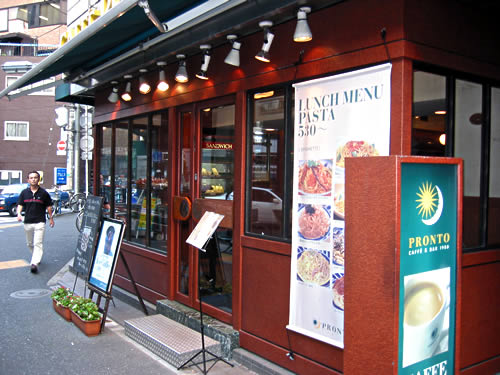
The entrance to the Pronto Coffee Shop around the corner from my hotel. Decent brew, surprisingly good croissants, and an amiable-enough atmosphere made it a satisfying place to start many of my days.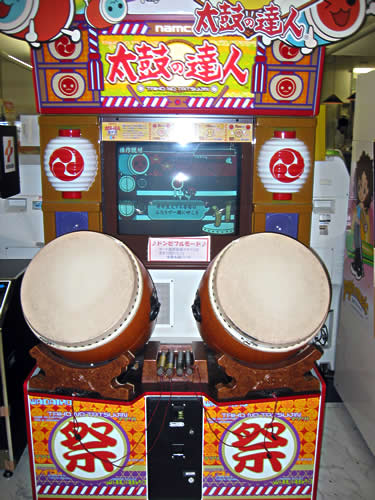
A video game that will likely not make the leap across the Pacific. It's like Dance Dance Revolution, but you play it as a taiko drummer.
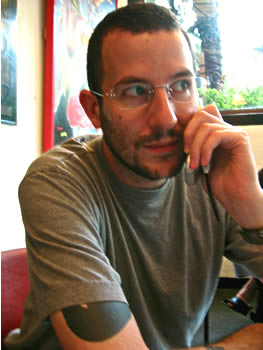
My delightful host, Adam Greenfield, engaged in that classic Japanese ritual of talking on the mobile phone.

Adam and his girlfriend, Nurri, showed me around Tokyo for a couple of days. They were the best hosts a clueless Bay Area boy could hope for!
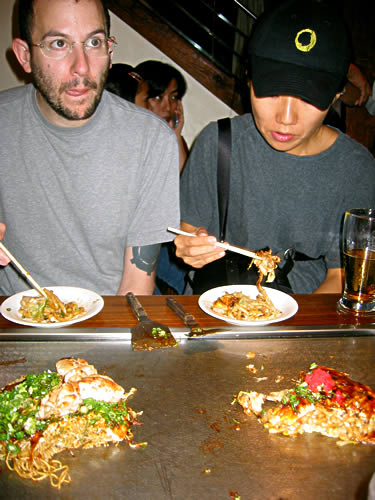
One of the best meals I had was a traditional Japanese dish called okonomiyaki, a delicious mound of various foods (noodles, cheese, meats, etc.) that you fry at your table.
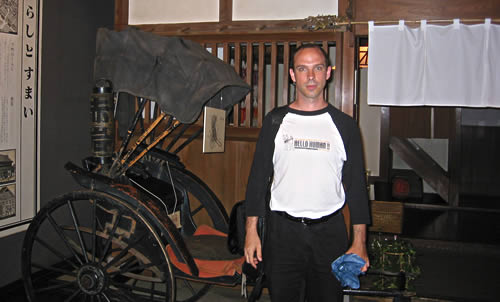
My favorite museum was the Shitamachi Museum, which recreates the shops and housing of Tokyo from right around before and after WWII. Perhaps the best thing about the place was...
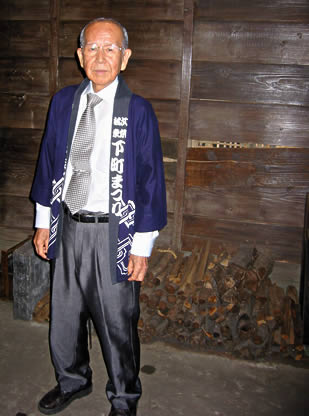
...my guide, whose name I never got. He's the one who invited me into the museum (and out of the pouring rain), got me to shell out my Y300 (a little less than US$3), and then proceeded to give me a personal tour of the place, showing me the various exhibits, and how people would have used such things (metalsmithing, candy store, apartment dwelling, etc. etc.) back in the day. On what was otherwise a rather dismal day (it rained from morning until night), this was a most delightful excursion.
Posted at 11:59 PM PST [0 comments]
|
|
Weblogs and Journalism. This evening I attended a panel discussion on "Weblogs: Challenging Mass Media and Society", sponsored by UC Berkeley's School of Journalism.I don't think I've ever prattled on this particular topic before, so I thought I'd got some thoughts out while still fresh-ish.The panel was Okay. Really hadn't said much that hadn't been said before in similar contexts. The person who got it most, in my mind, was Scott Rosenberg. He was possibly the first "journalist" to write about weblogs, and definitely the first to do so intelligently. Scott "gets" the formal quality of weblogs, which surprisingly few do. In these kinds of discussions, the question, "Are weblogs journalism?" inevitably comes up, demonstrating how people confuse form and content. Weblogs are a form (not a medium... the Web is a medium), and journalism is a practice. Journalism can be practiced in many media and forms. The two are, at best orthogonal. One definitely doesn't replace the other.Scott pointed out how weblogs are something that, simply, couldn't appear in any other medium, and that's what makes them special. Andrew Dillon posited that home pages were the first uniquely digital genre, and I would argue that weblogs are the second.For what it's worth, I've learned that I find discussions of the "impact" of weblogs on journalism kind of non-starters. There's inevitably a tension or dichotomy set up that I don't believe is really there.Over dinner afterward, panel moderator Paul Grabowicz noted the irony of how the professional (and perhaps bitter) journalists were more than willing to call all manner of weblogs "journalism", whereas the two bloggers (that would be Rebecca and Meg) held the practice of journalism to a standard far higher than most weblogs achieved. Anyway.
Posted at 11:38 PM PST [10 comments]
|
| September 13, 2002 |
|
Progress Paralysis: Eight Steps To Get Your Web Site Moving Again. I wrote an article for New Architect encouraging people doing web work to stop, step back, reconsider, and approach their problems thoughtfully and methodically. My original draft played on the "Progress Paralysis" theme more, likening it to a disease/affliction, and the article was filled with extended surgical/anatomical metaphors. I kind of miss them, as I think they gave the piece a hook that would have made the admittedly dry content more memorable. However, the editors have probably served their readers well by not subjecting them to discussions of organ transplants.Please peruse, and feel free to comment here!
Posted at 10:12 AM PST [2 comments]
|
| September 11, 2002 |
|
So Why Aren't Avis.com and Hertz.com the Same? On Bloug, Lou Rosenfeld relays a question from a reader:"Can two or more entities have identical or nearly identical information architectures?"Take Hertz and Avis, for instance. Obviously their labeling differs, but they are in the same business and serve the same kinds of customers. Could it not be said that their information architecture therefore overlaps greatly? ... What I'm driving at is this: Why should an entity need to do in-depth information architecture research if another similar entity has already been down that path?" This is one of the things I was getting at in an awkwardly-titled article I wrote for Adaptive Path, The Pendulum Returns: Unifying the Online Presence of Decentralized Organizations. In it, I wrote this equation:User Goals and Tasks + Company Mission + Business Goals = Branded Design Solution. The user goals tell us WHAT to design. The company mission tells us HOW to design it. And the business goals remind us WHY we're designing it. As the reader points out, for Avis and Hertz, user goals are probably identical, and business goals are likely very similar. So that means the WHAT and WHY are aligned. But the company mission is potentially very different. What is the company's reason for being? What is it that sets it apart from other companies? What are its values? From Avis.com's Mission and Values page: "Mission: To ensure a stress-free rental experience by providing safe, dependable vehicles and special services designed to win customer loyalty." It then lists as vaues Integrity, Quality, Value, Community Responsibility, Teamwork, and Respect for the Individual. Hertz doesn't promote any values on their site (nor could I find "values" on any other rental car site). Still, we can make some assumptions here. Avis is very much about appealing to the individual, to persons -- it makes a very concerted effort to talk to you, the customer. Hertz, on the other hand, is more of a business-to-business deal, stressing the corporate. Hertz would likely offer a more no-nonsense experience, appealing to the business user. Avis would likely offer a friendlier, more tailored experience, allowed to meet the needs of specific individuals. Again, the users have extremely similar goals, and the business goals are doubtless identical (make money, squeeze margins, etc.), but how they achieve that is different, informed by their distinct reasons for being.
Posted at 07:33 PM PST [4 comments]
|
|
Everybody's a Designer. Check out Jon Udell's column from a week or so ago, discussing Alan Cooper's interaction design methodology and philosophy.Udell addresses a point that I've always taken issue with, which is Cooper's seemingly arrogant stance that only a chosen few are qualified/suitable for practicing user experience design. That doing this kind of work--understanding what the market needs, how it meets business goals, and designing solutions for digital media--can only properly be done by highly experienced practitioners. While the highly experienced can doubtless do it better than the average Joe, Cooper's stance seems to ignore the reality that there will always be a far greater need for interaction design (and information architecture, and user research) than there are people who practice it. You can see that with usability, and how usability has moved out of the hands of the exalted few ("human factors" engineers, ergonomists, etc.) and into the hands of folks in the organization. Similarly, the methods and understandings of interaction design and information architecture need to be disseminated as widely as possible, because the bulk of that work is not going to be done by highly paid consultants, but by middle managers trying to solve immediate problems. This is what has lead to Adaptive Path's "open source" approach for sharing methodology--we want as many people to know what we know. There's a very selfish reason for this--we (the partners) are sick of dealing with bad designs, so anything we can do to generally raise the bar of design practice will, we hope, make our lives easier as well. I don't want bad designs to proliferate simply because companies can't afford highly-paid consultants. Also, and I think we as user experience designers need to be honest about this, this stuff, as Steve Krug put it, is not rocket surgery. While experience, skill, and talent will lead to better designs, any reasonably competent, intelligent, and observant person can, with some guidance, get much of the way there. There *will*, of course, be a place for highly-paid consultants--either at big companies, who can afford it, or people seeking innovation, to go beyond standard practice. But, increasingly, I suspect that highly-paid consultants' most crucial role in society will be to take the knowledge gained from their highly-paid work, and share it with as many people as possible, to encourage a base level of competence in our digital designs.
Posted at 05:43 PM PST [8 comments]
|
| September 5, 2002 |
|
Nerds are the same the world over. Is the lesson of today. I spent the entire day, cooped up in my hotel, working on a report for the client. Didn't get out until this evening, when Jun came by to get me and take me out to a nabe dinner near where I'm staying. He gathered a bunch of friends of his, so there we were, 6 guys, sitting on a tatami floor, slurping udon and talking about....Weblogs.Online communities. Information architecture.Unix.Demonstrations of applications using VRML (one guy opened his laptop and fired it up during the meal).Peer-to-peer. SIGGRAPH.ASCII Art.Dinner was good. Nabe-style food is prepared by the diners in an iron bowl over a flame at the table, and eaten family-style. We had udon with various meats and vegetables.The most exciting part--placing the live shrimp into the hot broth, the little sucker freaked out (to be expected), startling me, and somehow he sprang out of the bowl and onto the table. (I don't know if it was my doing or his). The meal ended at a Caffe Veloce, a chain of coffee houses. At 11pm, the establishment played "Auld Lang Syne," which Jun informed me is the standard way of telling the customers, "You don't have to go home, but you can't stay here!" In Tokyo, every day is New Years Eve!
Posted at 08:10 AM PST [2 comments]
|
| September 3, 2002 |
|
Obligatory Tokyo Photos. 
I had an excellent cup of coffee at the Coffee Embassy. It wasn't cheap (400 yen, ~$3.25), but it was specially brewed, just for me, and it tasted great. I enjoyed the lack of spacing between the two words in this sign.

Like in America, EXIT signs are everywhere. Unlike in America, they depict someone running headlong through a door, as if he's making a getaway.

Obligatory "funny product" photo. It's hot, you get thirsty, and there are these vending machines on every block, offering assorted beverages. Well, I had to try Pocari Sweat, an "ion supply drink." Verdict: not very good. Don't know how my ions fared.
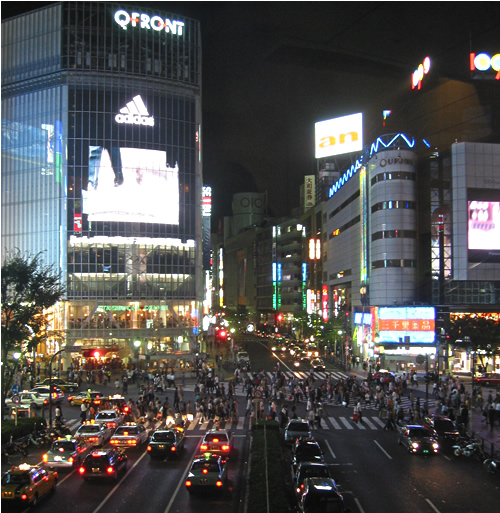
Obligatory "crazy intersection" photo. This is Shibuya. Throngs of people cross every which way with each turning of the light.
Posted at 11:48 PM PST [2 comments]
|
|
My Achilles Heel, Money-wise. Typically, my drink of choice is juice. Grapefruit juice in the morning, a Nantucket nectar for lunch. Or Odwalla. Something with fruit. I'm not a big cola drinker. However, in Tokyo, even the cheapest apple-juice-from-concentrate costs US$2.50. The good stuff can easily go for double that. But, considering it's around 90 degrees with a good 50-80% humidity, I'll shell out for it.
Posted at 11:33 PM PST [0 comments]
|
|
Today was a good food day. Eating began around 7am, when, after having wandered with Tsukiji, I had sushi for breakfast (as was recommended by a couple guide books). Something I could definitely get used to. That makes my second sushi meal since I've arrived (the first was a conveyor belt sushi place). The maguro (tuna) this morning was excellent. The other fishes were good, though no better than you'd get at a good Bay Area sushi restaurant (the same could be said for the conveyor belt sushi I ate). Still. Sushi. Mmmm.After a noon-time nap that last until 1:30, I went to the teppanyaki restaurant atop the hotel I'm staying. Teppanyaki is what I would have simply referred to as Benihana-style cooking (and thus probably be insulting someone's ancestors or something), where in the meat and vegetables are prepared on a large flat hot metal surface. I had a simple lunch that was quite tasty--steak (already cut into bit size portions!), with vegetables and salad. For dessert was a delightful apricot sherbet. The funniest thing about the meal: The full lunch was a set offer, costing 1,800 yen (about $15). I also ordered a Coke. Which, when I got the check, I found out cost 750 yen. Almost half the price of the meal.
Posted at 11:31 PM PST [0 comments]
|
|
Morning Walk to Tsukiji. Guidebooks all around implore the Tokyo tourist to visit Tsukiji, specifically the fish market, around 6 am any morning. So, today, I did.Exiting at the Ginza Station, I headed south on Harumi-dori. Snapped this oddly tranquil pic.
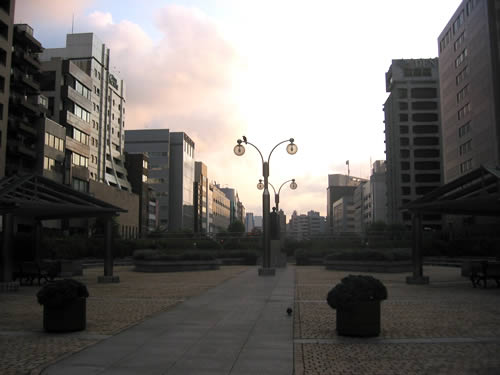
Continuing on, I turned a corner, and came across the first market stalls at Tsukiji.
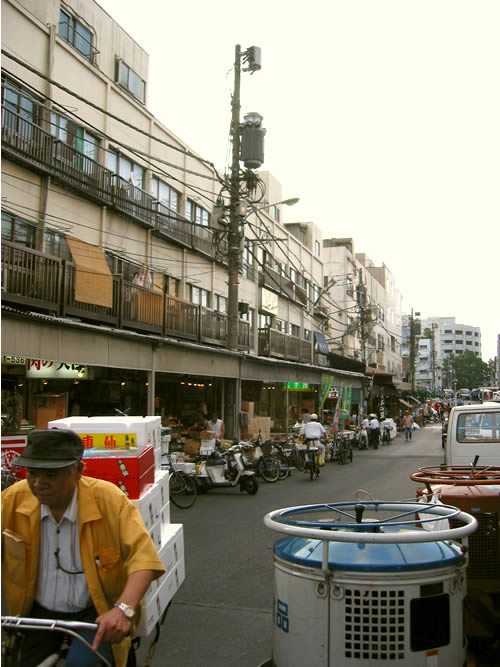
And then into the belly of the beast. The fish market is a massive place, stalls everywhere, little aisles for walking, and various forms of vehicles: bicycles, cars, trucks, and these weird cargo trucks you see here:
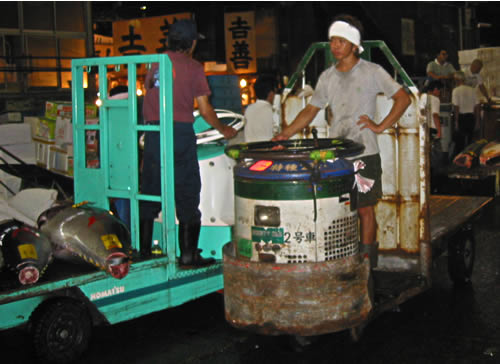
Excuse the lack of focus...
And, well, all manner of fish can be purchased in the stalls...
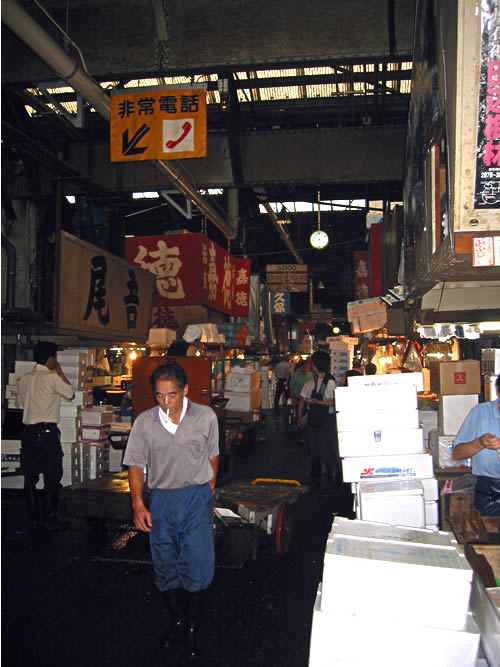
Looking down an aisle between stalls

Maybe you'd like some tako?
...or some unagi?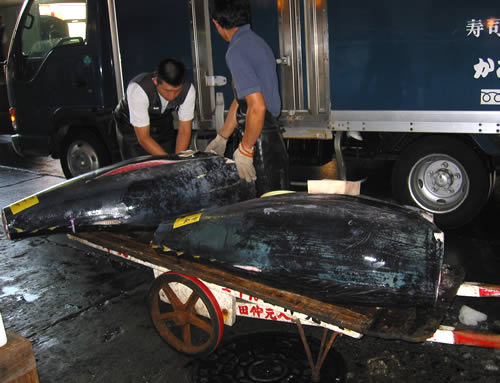
Mmmm... massive fish carcasses
I love the colors in the marketAnd now, as a special treat, a video to give some sense of the craziness of the motion. There seems to be little rhyme nor reason to how people move in the place, be it on foot, bike, or in a car. And I'm surprised that there seem to be no accidents, at least, no major ones. Somehow, people push right through, creating an amazing emerging flow. BONUS: At the end of the video, there's a near-accident, which, I think, is what prompts my last 5 seconds of shooting of the ground. And yes, I was foolish enough to wear sandals in the watery market.Tsukiji Video(4808k file) It claims to be an "AVI", but I could only get it to work in QuickTime. Blame my Canon digital camera. Tsukiji was the first thing I saw in Tokyo that I really enjoyed. I do like open markets, and I like that this all occurs at a very human level. I find the typical Tokyo neighborhood of stores and restaurants piled story-upon-story to be rather offputting.
Posted at 07:21 PM PST [6 comments]
|
|
User Testing in Japan. For the folks who read my site for "usability information" (and lord knows why there would be any left), here's some perspective on performing user testing in Japan.So far, we've had three user tests. They've been performed in the offices of Ion Global, with the test in one room, captured on video, and a cable allowing us to see the video through a monitor in another room. I never did like those two-way mirror set ups.The people include: Tomoo, who is acting as a kind of project manager for Ion Global; Miki Imazu, a budding usability moderator (with past experience in marketing); and Christian Storms, our interpreter, who provides play-by-play so that I and the client (James, from PeopleSoft) have a clue as to what is happening.The testing has all been pretty straightforward. A common conception of the Japanese people is that they will be unwilling to speak out in a user testing environment, for fear of being impolite. Well, after three tests, that has, thankfully, proven not to be the case. With some prompting, they are more than happy to "think aloud", be it praise or criticism (though the testers have been more apologetic after dissing the design). In all, the kinds of commentary we're hearing from Japanese testers is pretty much in line with what we'd hear in America. One interesting difference is a focus on color. While American testers might simply state that they do or don't like a certain color, Japanese testers have voiced interest in why a certain color was chosen, suggesting they're reading potential meaning into colors. Recipe For Foreign Language User Testing
Equipment
- 1 video camera
- 1 video tape per participant
- 1 computer, with monitor
- Video cable(s) long enough to connect camera and television
- 1 scan converter (optional)
- 1 video mixing board (optional)
- 1 television monitor
- 1 microphone
- 1 tape recorder
- 1 audio tape per participantPeople
- 1 project manager/overseer
- 1 moderator (could be same as project manager)
- 1 interpreter
- Enough participants to witness trendsSet up video camera, with video tape. If you want to shell out the extra money for a scan converter (to capture what's on the screen), and a video mixing board (for picture-in-picture), great. It's not necessary. You can have just one camera, looking over the participant's shoulder, onto the screen, so you can get part of the participant's face and the entire screen. Some folks attach mirrors to the monitors so you can capture face and screen that way.Run cable to monitor (or mixing board). If you're cable isn't long enough, get an extension cable. Daisy chain them if you have to. Provide tape recorder and microphone to interpreter. When the test begins, the moderator will turn on the camera, and then begin speaking with the participant in the local language. The interpreter will provide a play-by-play for observers in the Other Room, which is also being recorded on audio tape. Back "home", you can relive the experience by playing the video tape through a television, turning down the sound, popping the audio tape in a stereo, fiddle with the timing so both tapes are synced, and then sit back and enjoy.
Posted at 06:45 AM PST [1 comment]
|
| September 1, 2002 |
|
Lunch. Unagi. Eel. Over rice. I love unagi nigiri, and this was like that, only much much larger, and with much much more rice. Good, filling meal. Wondering if I should change the dates of my post to Tokyo time, which is 16 hours ahead of Pacific Time. See, where I'm at, it's September 2, though the date on this page says September 1. Dude. I'm posting FROM THE FUTURE. Things are different here. I took a flying car to get from Narita Airport to my hotel.
Posted at 10:12 PM PST [1 comment]
|
|
Hotel fitness center. At 7am, 6 people working out in the fitness center (exercycles, stairmasters, treadmills). All gaijin. National Geographic show on the television. I'm torn between the comfort of the familiar and the desire to explore.
Posted at 03:47 PM PST [1 comment]
|
|
Globalization working for me. Thank goodness "espresso doppio" pretty much means the same thing in any language...
Posted at 03:20 AM PST [3 comments]
|
|
|
All contents of peterme.com are © 1998 - 2002 Peter Merholz. |



















 I can hear the public thinking, "Oh dear god. Is Peter talking about a work of fiction? A novel? You mean, he occasionally allows himself flights of fancy?" Yes. Occasionally. There's a little to story as to why I read
I can hear the public thinking, "Oh dear god. Is Peter talking about a work of fiction? A novel? You mean, he occasionally allows himself flights of fancy?" Yes. Occasionally. There's a little to story as to why I read  It's pretty much a given that anyone who calls themselves an "information architect" will buy
It's pretty much a given that anyone who calls themselves an "information architect" will buy  Though not indispensible, a remarkably helpful guidebook for my Tokyo sojourn was Justin Hall's
Though not indispensible, a remarkably helpful guidebook for my Tokyo sojourn was Justin Hall's